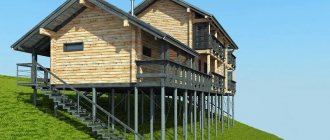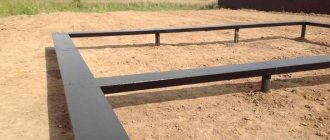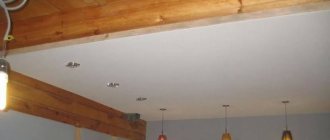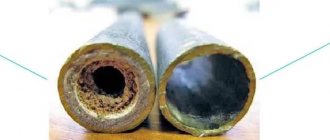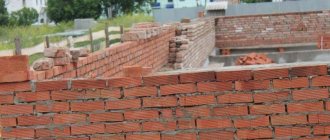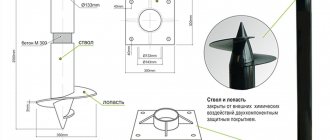It is difficult for a non-specialist to know which foundation to choose for a house. Traditional strip and slab laying is not used in all cases - there are a number of restrictions. In addition, they are quite expensive, which is not always justified economically.
A pile foundation with a grillage will require less investment, therefore, if conditions permit, it is more profitable to use it.
It seems that this is a house “on legs” Source sampochinil.ru
What is a grillage type pile foundation?
Such a foundation is a structure of piles buried in the ground below the freezing depth of the soil, and connected at the top using a metal or concrete strip (grillage). The supports can be combined by one common slab located at ground level or slightly above. The structure, built in accordance with all the rules, is reliable and has a long service life - several decades.
Concrete grillage Source domsdelat.ru
Here you can clearly see what a foundation grillage is - this is the entire upper part of any pile foundation, which is also called the “cap”. The purpose of the grillage is to evenly distribute the load from the load-bearing elements of the structure onto the piles and, accordingly, onto the ground.
There are several types of grillage:
- Made. It consists of separate elements, which are a structure of three piles reinforced with a welded frame. To install them, you will need a crane.
Prefabricated grillage from beams Source orchardo.ru
- Monolithic reinforced concrete. It is a solid plate or strip. Poured directly at the construction site.
Monolithic cast reinforced concrete grillage Source 24stroim-dom.by
- Prefabricated monolithic. An intermediate option, made from prefabricated parts, which in turn are assembled in a factory, and are already cemented in place using locks and key connections.
Calculating height above ground
The height of the pile foundation above ground level is determined by the height of the top line of the grillage.
Selecting the correct value is determined by several factors:
- Snow cover thickness in winter.
- Possibility of flooding, water level during spring floods.
- Groundwater level.
- Temperature conditions in the region.
By comparing these parameters, we come to the choice of the optimal height of the grillage.
The optimal values are considered to be 30-40 cm for conventional bases and 1.5-1.7 m in the presence of a basement.
IMPORTANT!
The possibility of equipping a basement room is extremely rare; most often, a technical underground is installed in which communications are located.
Advantages and disadvantages of a pile-grillage foundation
Each of the listed types of foundation has advantages and disadvantages that are taken into account during design in order to prevent excessive consumption of materials, deformations and cracks in supporting structures. Among the most common types of foundation, designers have a choice between strip, slab, pile-grillage and pile. If we compare the pros and cons of a pile-grillage foundation with other types of foundations, then SRF wins in many ways.
In fact, the advantages of a pile-grillage foundation far outweigh the disadvantages Source lowcarb-ernaehrung.info
The properties of a foundation with a grillage determine the following advantages of its use:
- applicable for any soil, including mobile and unstable, water-saturated or peaty;
- convenient when building a house in an area with uneven terrain (for example, on a slope);
- does not require large consumption of materials;
- has a significant service life;
- installation is slightly dependent on weather conditions - work is allowed at air temperatures down to -10°C;
- It is stable and has good load-bearing capacity.
On water-saturated soils, building a foundation requires special skill and accurate calculations Source termeszetvedelem.hu
Cons:
- there are restrictions related to bearing capacity: the foundation is used only for one- and two-story buildings;
- construction of a basement or basement is possible, but involves complex and costly design solutions;
- installation requires high precision, so it is strongly recommended to entrust it to specialists;
- installation work requires the use of special equipment.
Types of pile-grillage foundations according to the method of immersion in the ground
- Driven. The supports are driven into the ground using construction equipment.
- Printed. It involves drilling wells, which are subsequently filled with concrete.
- Screw. It is a method of screwing in piles using special equipment.
A special expense item is the use of special equipment Source blog-potolok.ru
See also: Catalog of companies that specialize in foundation repair and design.
What kind of concrete is used for filling?
According to the documentation, work can be performed with M350 grade solution.
The design documentation regulates the grade of concrete for piles M350 or low-grade M200. The characteristics of the mixture make it possible to use it for the production of products and structures that carry extremely high loads. Strength characteristics belong to class B 25, where a pressure of 25 MPa per 1 m2, which creates a high level of wear resistance.
Types of piles used
Depending on the method of immersion, piles are selected:
- Hammers. For them, wells are prepared in advance, with a depth of 1/3 of the height of the pile. For installation, special construction equipment is used: pressing machine, vibratory hammer, vibratory hammer. Wooden, steel, reinforced concrete and hollow supports are used as driven supports.
Reinforced concrete piles: if the installation technology is followed, the supports will last for many decades Source block-gbi.ru
- Bored. Formwork and reinforcement are placed in the well for strength, then filled with concrete.
- Drilling. Wells are drilled in advance, into which reinforced concrete supports are then installed.
- Screw. They are hollow pipes, at the bottom of which there are blades and a pointed tip. The supports are screwed into the ground using special equipment.
UBM-85 for driving screw piles Source stroy-dom-pravilno.ru
Piles can have a rectangular or circular cross-section. The materials used for them are concrete, reinforced concrete, steel of various grades, and mostly coniferous wood. Of the tree species, larch is considered the most suitable, containing a large amount of resins that protect the piles from rotting.
Driven metal piles are one of the cheapest and most durable Source blog-potolok.ru
Device
The main part of the work on creating a pile foundation comes down to immersing the trunks in the ground.
This is the most difficult and critical stage, which determines the strength and stability of the entire system.
If failure, failure, or other problems occur during immersion, the ability of the entire base to perform its function is compromised. Any deviations during the work indicate non-compliance with the technology, unscrupulous geological survey of the site or low quality of piles .
The second stage is the creation of a grillage. It performs equally important functions and must meet all existing requirements.
The technology of creation directly depends on the type of piles, material of manufacture and parameters of the future house .
For light buildings, the grillage can be made of wood (a beam or a bundle assembled from an edged board until the desired thickness is obtained).
When using metal piles, it is customary to create a grillage from metal - a channel, an I-beam or a profiled pipe.
For reinforced concrete piles, the grillage is cast from concrete using a technology reminiscent of making a strip foundation.
NOTE!
Both stages of creating a pile foundation must be carried out by experienced builders or, at a minimum, under the supervision of a competent specialist. There may be violations of the technology or deviations from the calculated parameters , which must be noticed and corrected in a timely manner, which is not always possible for untrained people.
Classification by depth
Depending on the position relative to the ground, there are 3 types of grillage:
- Low or recessed. Its peculiarity is that it is installed below ground level, that is, in the ground. The grillage is placed on a sand cushion.
- Ground. Located at surface level.
- Tall or hanging. It is located above ground level on high supports. If groundwater flows close to the surface, this type of grillage is used.
Recessed grillage Source nauka-i-religia.ru
Recessed grillages are used only in cases of extreme necessity, since their installation is comparable in complexity to installing a shallow strip foundation: it is necessary to dig a pit, arrange a drainage sand cushion, make formwork, but also install piles.
Unlike buried and above-ground grillages, hanging grillages are not as labor-intensive and, as a result, less expensive.
How much does it cost to build?
The main pricing factors include:
- Number of piles.
- Characteristics of the rods (size, blade configuration, steel strength, quality of anti-corrosion coating).
- The type of soil in the areas and the depth of underground sources.
- Design loads.
- The need to install piping, etc.
The average market cost of building a turnkey pile-screw foundation is presented in the table:
| Typical house sizes | Number of piles | Cost, rub. |
| 6 by 6 | 12 | 34800 |
| 6 by 8 | 15 | 43500 |
| 8 by 8 | 16 | 49600 |
| 12 by 12 | 25 | 77500 |
Stages of installation of a pile foundation with a grillage
The equipment of a pile-grillage foundation is divided into the preparatory stage and the installation itself. At each stage you have to perform several types of work:
Preliminary work
- To build a foundation, you first need a project , which is created on the basis of calculations of loads, the expected depth of immersion of piles, and what materials the foundation is planned from.
A project from a professional is a guarantee of safety, long service life, as well as savings in materials and finances Source nl.decorexpro.com
- Then the area is prepared : debris, topsoil and plant roots are removed.
- The territory is : the location of supports, grillage, load-bearing structures of partitions is noted.
Attention! Deviation from the project is always the cause of negative consequences, such as curvature of the foundation, the occurrence of unforeseen expenses, and more. Therefore, it is important that the project is drawn up by professionals and is tied to the area.
The work of a “professional” is immediately visible Source blog-potolok.ru
- A trench is dug for the grillage. Its walls and bottom are checked for evenness with a level. After this, a sand cushion is laid and compacted.
- Wells are drilled for supports , at the bottom of which a sand cushion is also placed. Waterproofing is placed in the pit: you can use a special film, several layers of roofing felt, or plastic pipes.
Technology for installing a pile-grillage foundation
- For the grillage, reinforced concrete beams are used or a monolithic tape is poured. A wooden rectangular formwork is prepared for it, which is secured with supports and lintels. At this stage it is also worth taking care of the sewerage and pipeline.
Photo of a pile-grillage foundation - after the concrete has dried, the formwork is removed Source bestroof.ru
- To increase the strength of the structure, a reinforced frame is placed in the well - 4 metal rods tied with wire. Then the concrete is poured. The tape is also reinforced.
- Next, concrete is poured first into the wells, then into the formwork. The concrete will take at least 10 days to set, after which the formwork will be dismantled.
How is the need for foundation materials calculated?
An accurate calculation can only be performed by a specialist - a civil engineer, who will rely on the requirements of SNiP and a number of indicators such as the strength of supports, grillage, bearing capacity of the foundation, soil resistance force, degree of shrinkage of the support under the influence of vertical load, etc. The specialist will determine the depth of immersion of the supports, their diameter, number, type of grillage and develop a diagram.
For a person without specialized education, calculations for a pile-grillage foundation look something like this Source ask.fm
When calculating the number of supports, they are based primarily on the load on the foundation, which consists of several indicators. Here it is necessary to know the mass of load-bearing walls, partitions, roofs, floor slabs, i.e. the entire mass of the building above the foundation. The payload produced by residents, household items and all other things is also taken into account. In calculations for private houses, an indicator of 150 kg/m² is used.
The last parameter for determining the total load is the weight of the snow mass that can accumulate on the roof in winter. The value generally used is 180 kg/m², but for a number of regions of the country it is slightly different. The resulting sum of loads is multiplied by the safety factor, which is 1.1 (sometimes 1.2 is used). Next, you can calculate the load on one pile.
It would not be out of place to add that online calculators for calculating materials that are widespread on the Internet should be treated very carefully. They may not take into account a number of important parameters.
Pouring monolithic tape
Concrete mixture of grade no lower than B17.5 can be ordered at the nearest RBU or prepared independently. A monolithic tape 40-50 cm high is poured in two stages. First, the first layer of 20-25 cm is poured, followed by vibratory compaction for 10 minutes. Then the second layer is poured, also with compaction.
Concrete must be supplied to the formwork using a concrete pump hose or a chute. Concrete should be poured carefully so as not to move the reinforced frame. The hardening time of concrete is 5-7 days. During this period, the tape must be provided with standard care. After the concrete has gained strength, the formwork can be dismantled and hydro- and thermal insulation work can begin.
Installing additional items
When constructing a pile-grillage foundation, it is necessary to arrange openings for ventilation in the foundation and lay pipes that can be used for heating, sewer, water supply systems and other communications. If you do not take care of the engineering and technical equipment of the house in time, later to install them you will have to partially destroy the grillage.
To preserve the foundation, it is imperative to provide vents for ventilation Source remontstroy.net
Requirements for creating a high-quality grillage foundation
Since the main loads on the grillage are bending forces, one of the key points when creating a grillage foundation is reinforcement, which significantly increases the strength of the structure.
Reinforcement diagram Source stroidominvest.ru
The second significant point concerns the hardening time of the concrete structure - which is a whole month. The grillage will be able to withstand the proper loads only after the concrete has completely hardened.
Possible mistakes when arranging the foundation
- The piles are not firmly attached to the grillage - thermal expansion during seasonal temperature fluctuations will soon loosen the fastening point.
- The piles are laid at too shallow a depth. Here, both excessive shrinkage of the foundation and squeezing out of loose piles in the layer below the freezing of the ground by forces of soil heaving cannot be ruled out. All this can lead to the destruction of the building.
- Inaccurate calculations. It's just a powder keg - you never know what might happen.
Why is it necessary to fill screw piles with concrete?
The design of the elements is made of various diameters with blades for screwing into the array with your own hands or with special equipment. The danger for a steel pipe is the freezing of water in winter, which leads to the destruction of the trunk. To avoid defects, the entire internal cavity is filled with concrete. The concreting process, in addition to bearing capacity, provides protection against moisture penetration. Waterproofing treatment on the inner surface of the rod is not done, since the sand-cement mortar acts as an absorbent.
Concrete foundations on screw piles are made for the following purposes:
- Preventing water from entering the barrel space. Liquid causes corrosion, and when water freezes, it needs more space than in its liquid state, which contributes to deformation of the pile element.
- Increased load-bearing capacity.
